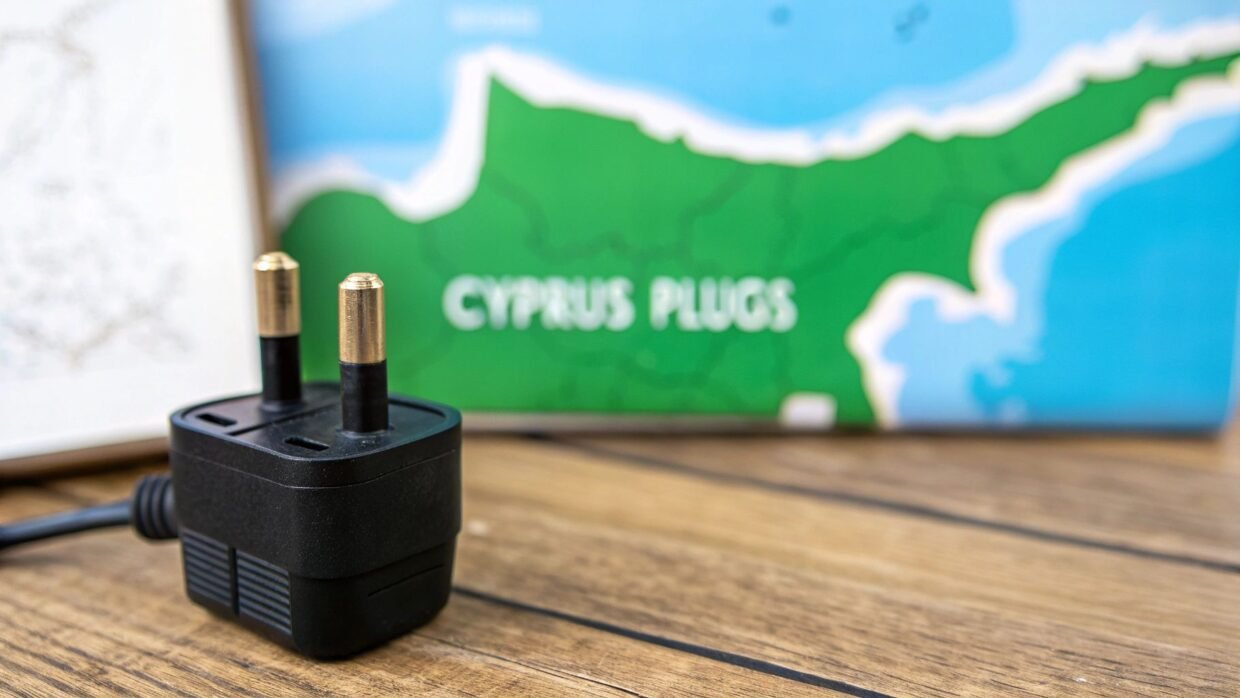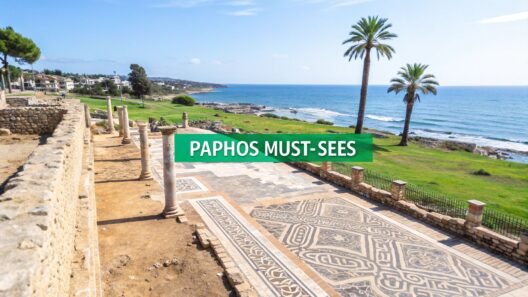Heading to Cyprus? Let's get the most important question out of the way first.
If you're wondering what plugs are used in Cyprus, the answer is refreshingly simple: it's the Type G plug. This is the sturdy, three-pronged plug you’ll find all over the United Kingdom.
Your Essential Guide to Cyprus Plugs and Sockets
For anyone travelling from the UK, this is brilliant news. It means your standard chargers and appliances will fit perfectly into the wall sockets—no adapters needed. Just pack your bags and go.
However, if you're coming from Europe, North America, or pretty much anywhere else, you'll absolutely need a travel adapter. Without one, you won't be able to plug anything in.
Think of the Type G plug as the familiar, reliable workhorse of the electrical world. Its design is instantly recognisable:
- Three robust, rectangular pins set in a triangle.
- An integrated fuse, which is a fantastic safety feature.
- A solid, snug fit that prevents it from accidentally falling out of the wall.
This isn't a random choice. Cyprus officially adopted the Type G standard, which was first introduced in the UK way back in 1947. This shared history has resulted in a safe and unified electrical system. If you're curious, you can learn more about the history behind Cypriot power standards to understand these long-standing ties.
Key Takeaway: The single most important thing to remember is that Cyprus exclusively uses the Type G socket. For anyone travelling from outside the UK, packing a Type G travel adapter is non-negotiable. It's the one small item that will save you from the major headache of not being able to charge your phone.
Why Cyprus Relies on the Super-Safe Type G Plug
Ever looked at a plug socket on holiday and wondered why they can't all just be the same? It’s a fair question, but the Type G plug you’ll find across Cyprus is a great example of a system chosen specifically for its robust, safety-first design. It's more than just a different shape; it’s a completely different approach to electrical safety.
The first thing you'll notice about a Type G plug is its three chunky, rectangular pins. They’re not just built that way to be different; each one has a specific and vital role to play. The whole design is a masterclass in preventing electrical accidents.
This image highlights the unique designs of various plug heads, making the sturdy build of the Type G plug obvious.
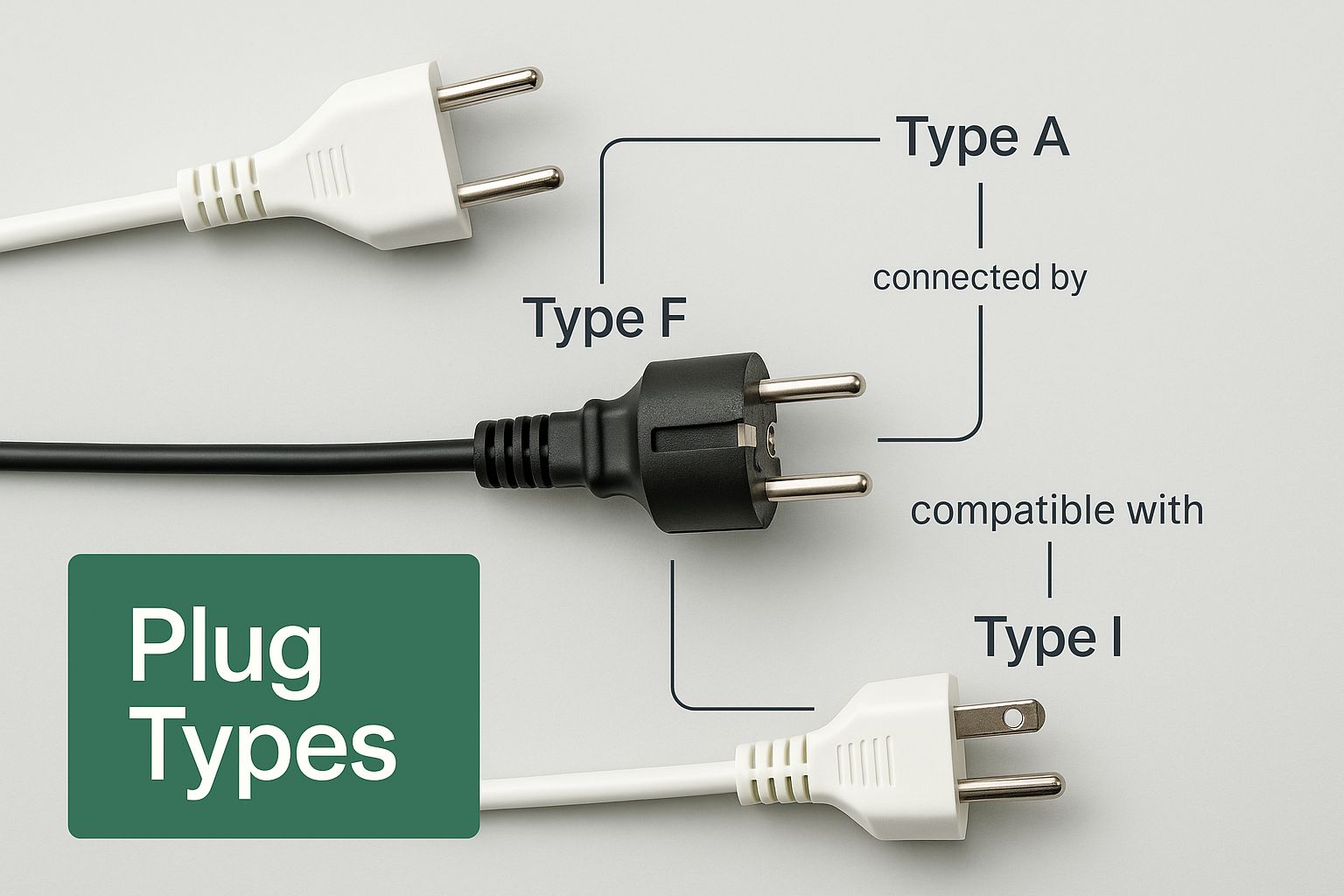
When you see it next to the smaller, two-pin plugs common in mainland Europe, you immediately get a sense of just how solid and thoughtfully constructed it is.
Engineered for Unbeatable Safety
What really makes the Type G plug stand out are its built-in safety features, many of which you just won't find on other common plug types. Think of it as having several layers of protection working together for you and your gadgets.
Key Insight: The Type G plug is widely regarded as one of the safest in the world. This is mainly down to its mandatory internal fuse and the clever design of its longer earth pin, which grounds the device before it even receives power.
Here’s a quick breakdown of how these features keep you safe:
- Live and Neutral Pins: These are the two shorter, horizontal pins that deliver the electrical current. You’ll notice they have plastic insulation at the base, which is a simple but effective feature to stop you from accidentally touching a live prong as you plug it in or pull it out.
- The Longer Earth Pin: The top, vertical pin is deliberately made slightly longer than the other two. This means when you push the plug into a socket, it connects to the earth wire before the live pins make contact. It’s a smart, pre-emptive safety measure that instantly grounds the appliance, directing any potential fault safely away.
- The Integrated Fuse: This is a huge one. Every single Type G plug must contain its own fuse. This acts like a mini circuit breaker right inside the plug. If your device ever tries to draw too much power, the fuse will blow and cut the connection. This prevents overheating and protects your electronics from damage, a significant safety advantage over most other plug systems.
Understanding Cyprus's Voltage: Will Your Devices Work?
Knowing which plug to bring is one thing, but the real make-or-break detail for your electronics is the voltage. Get this wrong, and you could be looking at a fried phone or a busted hairdryer. It sounds intimidating, but thankfully, Cyprus keeps things pretty simple.
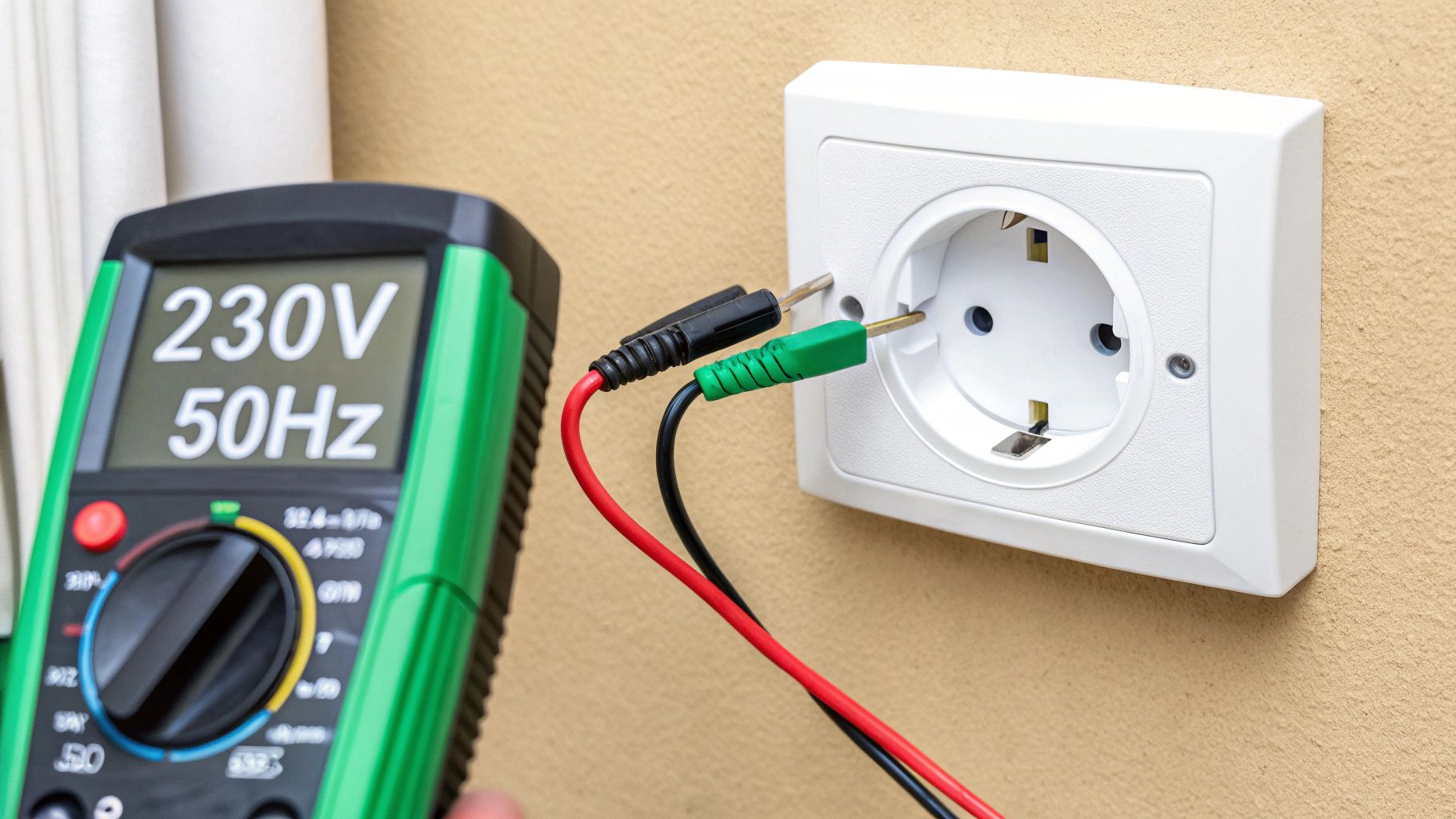
Think of it like water pressure. If your device is a gentle garden sprinkler designed for low pressure, you wouldn't connect it to a high-pressure fire hose. The principle is exactly the same for electricity.
Cyprus, like much of Europe, runs on a 240V supply voltage and 50Hz frequency. This standardisation is part of a wider system, and it's interesting to see how these regulations have been harmonised since Cyprus is in the EU.
Great news for anyone visiting from the UK: The electricity supply in Cyprus is practically identical to what you have at home. Your gear will work perfectly without any fuss—no converters needed.
Adapters vs. Converters: What’s The Difference?
This is where travellers from North America (used to 120V) or other parts of the world need to pay close attention. The key is to check if your device is ‘dual-voltage’.
You’ll find this information on a small label on the device’s power brick or charger. It’s often in tiny print, so you might need to look closely!
- INPUT: 100-240V, 50/60Hz: If you see this, you're golden. This means the device is 'dual-voltage' and can automatically handle anything from 100V to 240V. All you need is a simple plug adapter to fit the Cypriot socket. Most modern electronics like laptops, phone chargers, and cameras are built this way.
- INPUT: 110V or 120V: If your label only shows a low voltage, your device is 'single-voltage'. Do not plug this into a 240V socket in Cyprus, as it will almost certainly damage it. For these items—often older hair straighteners or electric shavers—you’ll need a voltage converter. This is a heavier, bulkier gadget that safely "steps down" the power from 240V to a level your appliance can handle.
Choosing the Best Travel Adapter for Cyprus
If you're heading to Cyprus from anywhere other than the UK, a travel adapter isn't just a good idea—it's an absolute necessity. Cyprus uses the same three-pronged, sturdy Type G plug as the UK, which means your devices from mainland Europe, North America, or Asia simply won't fit into the sockets.
Figuring this out before you travel will save you a lot of hassle, not to mention the inflated prices you’ll pay for a flimsy adapter at the airport.
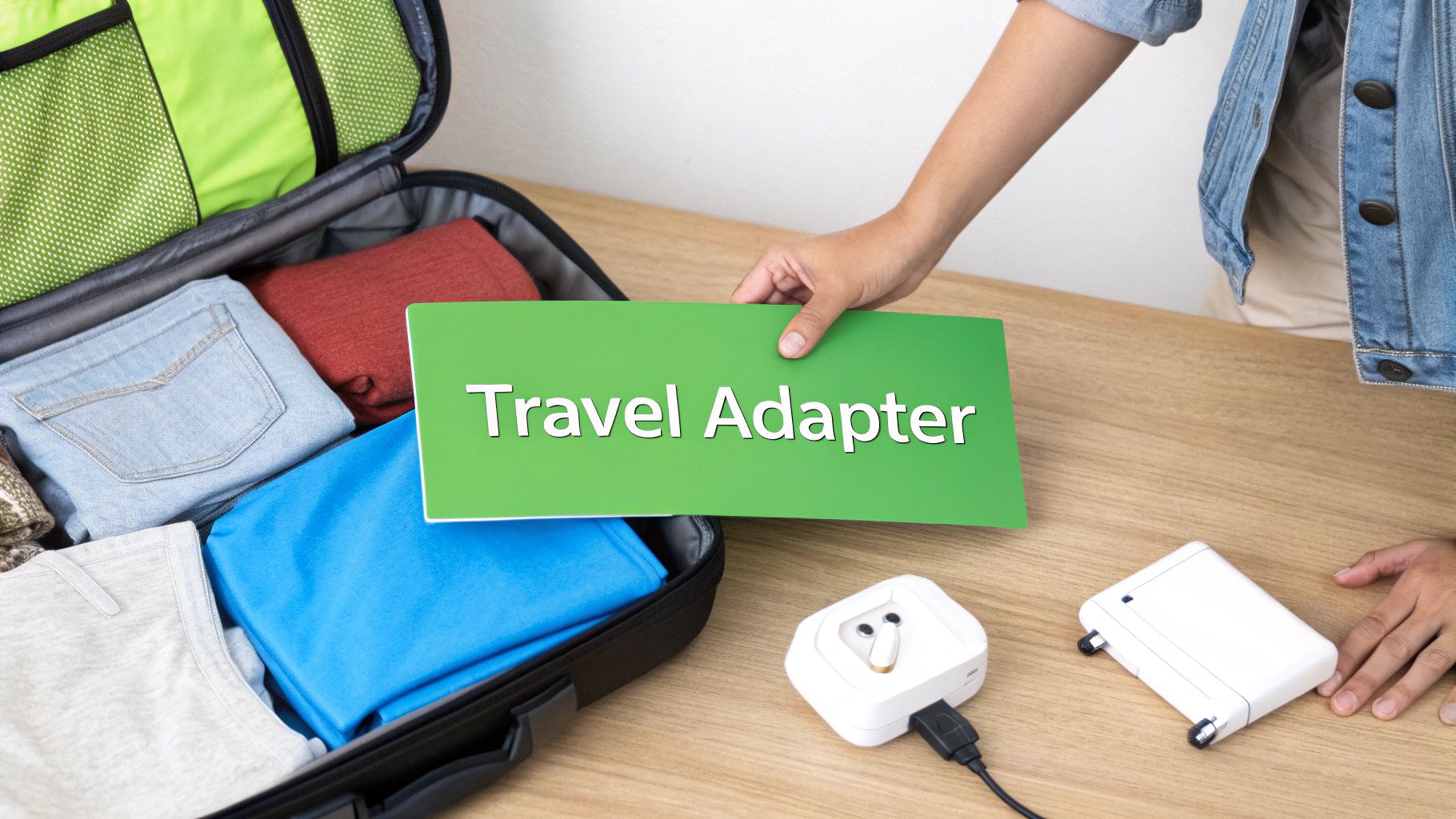
When it comes to choosing, you're looking at two main contenders: a simple, single-country adapter or a more versatile universal one. The right one for you really depends on how you travel.
A single-country Type G adapter is the no-fuss option. It’s a small, dedicated gadget that does one job perfectly: converting your plug to fit the Cypriot format. They’re generally cheap and light, making them a fantastic choice if your travel plans start and end in Cyprus.
On the other hand, a universal adapter is a seasoned globetrotter’s best friend. This all-in-one device usually has a clever system of sliding pins and multiple inputs, ready for outlets in dozens of countries. It might be a bit bulkier, but its sheer flexibility is a lifesaver if you're a frequent international traveller.
Key Features to Look For
Don't just grab the first one you see. A quality adapter is a guardian for your expensive electronics, so it pays to be a little picky. Here’s what I always look for:
- Safety First: Check for a BS 8546 certification. This is the British Standard, and it means the adapter has passed strict safety tests. It’s your best guarantee of quality.
- Handy USB Ports: Many modern adapters now come with built-in USB-A and even USB-C ports. This is a game-changer, letting you charge your phone, tablet, and camera battery all from a single socket.
- Proper Earthing: The Type G system is earthed for safety, so your adapter must have three pins to match. A two-pin adapter won't be earthed, which can be risky for certain appliances.
Traveler’s Tip: I can't stress this enough: buy your adapter from a reputable shop before you leave home. The ones sold in airports or tourist traps are often overpriced, uncertified, and can be unreliable—or worse, a safety hazard.
Putting a little thought into a reliable adapter is a small step that makes a big difference. For those planning their trip, our guide on how to fly to Cyprus from the UK has plenty more tips to help you get here smoothly.
Right, let's get down to the practical side of things. Knowing the theory is one thing, but making sure your phone doesn't die just as you’re about to capture that perfect sunset in Paphos is what really matters. A few simple tricks will keep your gadgets charged and ready for adventure across the island.
Before you even think about packing, take a moment to inspect your chargers. It’s a simple step that can save you a lot of headaches later. Most modern electronics like phones, cameras, and laptops are designed for global travel, but it's always wise to be 100% sure. Just check the tiny print on the power brick itself.
Pro Tip: Look for the 'INPUT' label on your charger. If you see something like '100-240V' printed there, you're in luck. This means your device is dual-voltage and will work perfectly fine in Cyprus. All you'll need is a basic plug adapter to fit the wall socket.
Smart Charging for Multiple Devices
Here’s a travel hack I swear by: pack a small, multi-socket power strip from your home country. This little trick is a game-changer. You can charge your phone, camera battery, and power bank all at the same time, while only needing one single Type G adapter for the wall. Suddenly, one Cypriot socket becomes three or four sockets you can actually use.
Now, what if you get to your hotel and realise you’ve left your adapter at home? Don't stress. They are easy to find all over Cyprus, but try to avoid the airport shops where you’ll pay a premium. A much better bet is to pop into:
- Supermarkets: Big chains like Alphamega or Papantoniou almost always have a section for household goods and electronics.
- Electronics Shops: Any shop selling mobile phones or computer bits and bobs will have what you need.
- Local Kiosks (Periptera): These small, local convenience stores are everywhere and often stock basic travel essentials.
Picking up an adapter is a minor expense, but it helps to be familiar with the local money. Get yourself prepared by reading our guide on what currency does Cyprus use. Having the right adapter and a little local cash on hand means you’ll never be left powerless.
Your Cyprus Plug Questions, Answered
Getting your head around a new country’s power sockets can feel a bit technical, but for Cyprus, it's actually pretty simple. Think of this as your final pre-flight check, where we’ll clear up those last-minute questions so you can get back to planning the fun stuff.
We'll tackle the common worries for visitors coming from different parts of the world and make sure the difference between a simple plug adapter and a beefier voltage converter is crystal clear. Let's make sure you pack the right kit.
Do I Need a Travel Adapter for Cyprus?
This is the big one, and the answer is all about where you're flying in from.
- Coming from the UK? You're in luck! Cyprus uses the exact same Type G three-pin plug as the UK. Your chargers and appliances will fit straight into the wall sockets, no adapter needed.
- From Europe or further afield? Yes, you will definitely need a travel adapter. If your plugs are the two-pin style common in Europe (Type C/F) or any other type from the Americas, Asia, or Australia, they won’t fit. You'll need a simple adapter to convert your plug to the Type G shape.
What's the Difference Between an Adapter and a Converter?
It’s easy to mix these two up, but understanding the difference is crucial for keeping your electronics safe.
An adapter is just a shape-shifter; it lets your plug fit into a different kind of socket. It doesn't touch the electricity itself. A converter, however, is a more powerful device that actually changes the electrical voltage to match what your appliance needs.
The good news is that most modern gadgets like your phone charger, camera battery charger, or laptop power brick are dual-voltage. Just check the tiny print on the plug – if you see something like "INPUT: 100-240V", you only need a simple plug adapter.
But if you have an older or simpler device from a country like the US that says "INPUT: 120V", it will need a voltage converter to work safely with Cyprus's 240V system.
Can I Use My Hairdryer or Straighteners in Cyprus?
This is where you need to be extra careful. Power-hungry appliances like hairdryers, straighteners, and curling tongs are often single-voltage, especially if they aren't specifically designed for travel.
If you're bringing one from a country with 110/120V electricity, check its label. Plugging a 120V hairdryer into a 240V socket (even with an adapter) is a recipe for disaster—you'll probably fry the motor in seconds. For these items, you'll either need a heavy-duty voltage converter or, a much easier option, simply buy an inexpensive travel-specific hairdryer that's built for dual voltage.
Planning your perfect island getaway involves more than just packing the right plugs. For comprehensive guides on everything from the best beaches to authentic local cuisine, let SayCyprus be your trusted source. Discover your next adventure.









